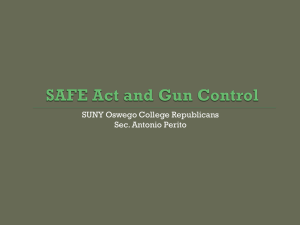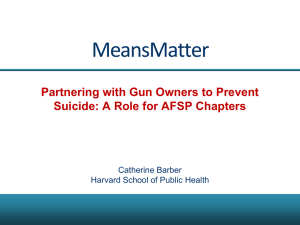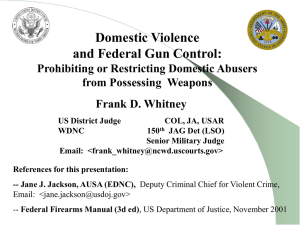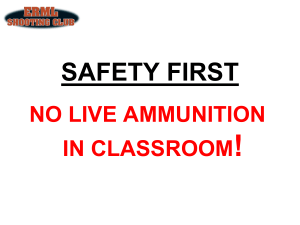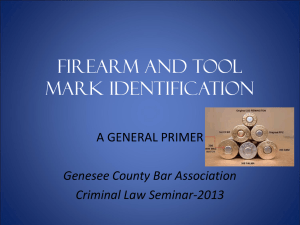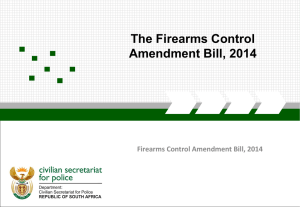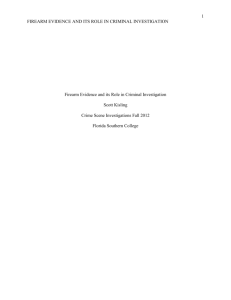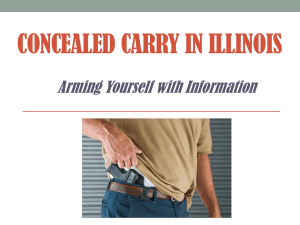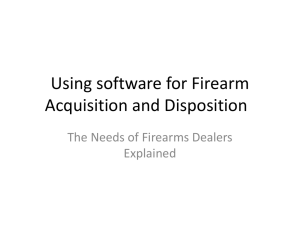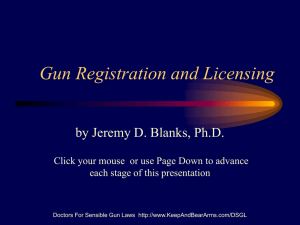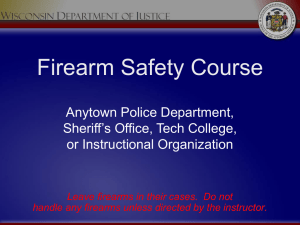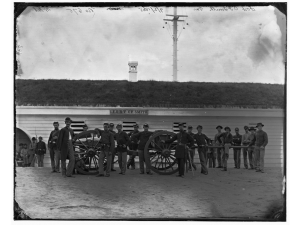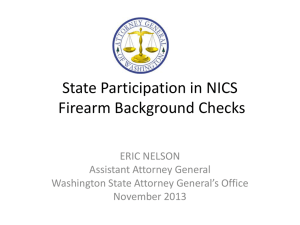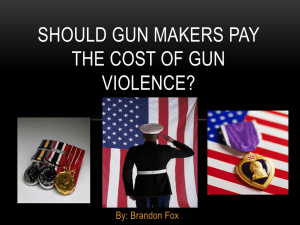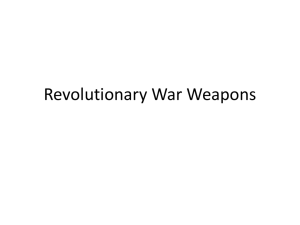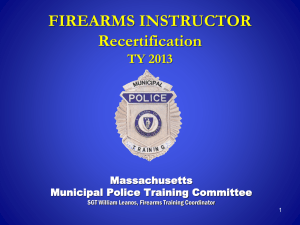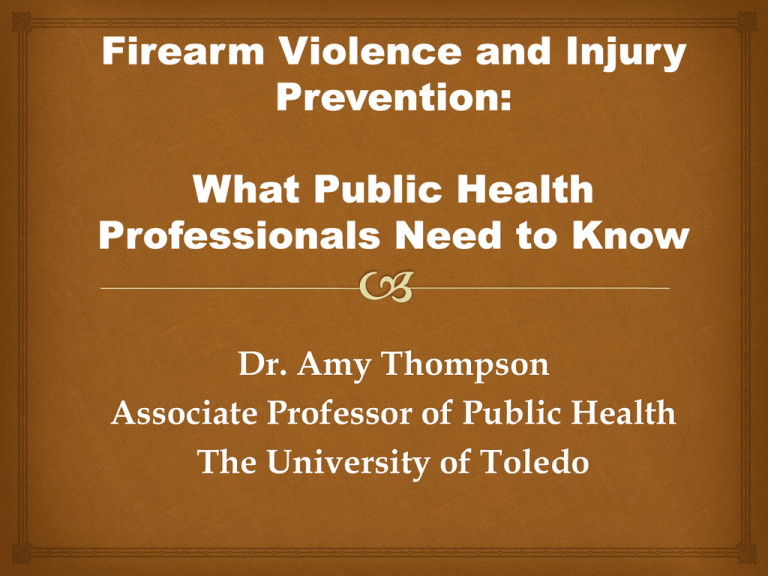
Dr. Amy Thompson
Associate Professor of Public Health
The University of Toledo
Deadly Shooting in
Arizona
This combination image of three file photos shows
Jared Lee Loughner, the gunman accused of trying to
assassinate Arizona Rep. Gabrielle Giffords and
killing six others.
West Haven Deaths Ruled
Murder-Suicide
January 20, 2010|By The Hartford Courant
WEST HAVEN — — The deaths of Selami Ozdemir and Shengyl
Rasim, who were fatally shot in their Blohm Street home on
Sunday, were officially ruled a murder-suicide by the office of
the state medical examiner on Tuesday.
Ozdemir shot his 25-year-old wife multiple times on Sunday
morning, then he shot himself in the chest, authorities said
Tuesday.
Presentation Objectives
After attending the presentation those in attendance will be
able to:
1. Discuss firearms as a leading cause of injury
in the U.S.
2. Explain the impact that firearms have in
schools and communities.
3. Identify barriers of implementation for
firearm control polices.
4. Discuss considerations for firearm injury
prevention programs
Our Recent Research
Price, J., Thompson, A., Khubchandani, J.&
Wiblishauser, M. Psychiatric Residency Directors’
“Perceptions of Firearm Access by the Mentally Ill”.
Manuscript under review Academic Psychiatry.
Thompson, A., Price, J., Dake, J. & Teeple, K et al.
“College Students Perceptions Regarding the
Carrying of Concealed Handguns on College
Campuses”. Manuscript under review American
Journal of College Health.
Price, J., Thompson, A. Payton, E et al., (2013). “Historically
Black University Presidents Perceptions of Firearms on
College Campuses”. Manuscript under review the Journal of
the National Medical Association.
Price, J., Thompson, A., Khubchandani, J, Wiblishauser, M.
& Dowling, J. (2013) .“Perceived Roles of Emergency
Department Physicians Regarding Anticipatory Guidance on
Firearm Safety” . Journal of Emergency Medicine. S07364679(12):01448-5.
Thompson, A., Price, J., Dake, J. & Teeple, K. (2012).“Faculty
Perceptions Regarding the Carrying of Concealed Handguns
on College Campuses”. Journal of Community Health DOI
10.1007/s10900-012-9626-0
Teeple, K., Thompson, A. & Price, J. (2012). “Armed
Campuses: The Current Status Of Concealed Guns On
College Campuses”. The Monograph of Eta Sigma Gamma. 29
(2):57-64..
Thompson, A., Khubchandani, J., Price, J. & Dowling, J.
(2011). “Sheriffs Perceptions of Firearm Policies”. Journal of
Community Health. 36 (5): 715-720.
Price JH, Thompson A, Khubchandani J, Mrdjenovich AJ,
Price JA. (2010). Firearm anticipatory guidance training in
psychiatric residency programs. Academic Psychiatry, 34:417423.
Thompson A, Price J, Mrdjenovich A, Khubchandani J. (2009).
“Reducing Firearm-Related Violence on College Campuses-Police Chiefs' Perceptions and Practices”. Journal of American
College Health 58:(3):247-254
Dowling J. Thompson A, Price J. (2009). “Campus
Communities and Firearm Violence: Fighting Crime by Arming
our Students and Faculty?” The Monograph of Eta Sigma Gamma
26:(2) 23-27
Price J, Mrdjenovich A, Thompson A, Dake J. (2009). “College
Counselors’ Perceptions and Practices Regarding Anticipatory
Guidance on Firearms”. American Journal of College Health
58:(2) 133-139.
Price J, Kinnison A, Dake J, Thompson A, Price J. (2007).
“Psychiatrists’ Practices and Perceptions Regarding
Anticipatory Guidance on Firearms”. American Journal of
Preventive Medicine 33(5):370-373.
Introduction
Firearm use and ownership have a significant
impact on individual communities in 3
ways:
1. Loss of human life.
2. Health care costs from firearm injury.
3. High economic cost associated with lost
productivity
Did You Know Most States
Do Not Have Laws that…….
Ban assault weapons
Ban high capacity ammunition clips
Restrict child access
Require a minimum age to possess a
firearm
Restrict the number of guns or volume
of ammunition purchased
Did You Know Most States
Do Not Have Laws that…….
Require safety mechanisms on guns
Require registration
Require a back ground check on all sales
Prohibit open carrying or concealed
carrying
Allow cities to have their own firearm laws
Allow you to sue gun manufacturers and
dealers
Introduction
In the year 2010 there were 31,672 deaths
-11,078 firearm homicide victims
-19,392 firearm suicide victims
-606 unintentional firearm injury deaths
-344 legal intervention
In 2010, there were 1,076 people killed by
firearms in Michigan.
In addition to the 31,672 people killed by
firearms 73,883 individuals were non-fatally
wounded by firearms
The Impact of Firearms
on Youth
The danger of firearm violence to
American youth is a realistic one; one
youth is killed with a firearm every
three hours.
Additionally, for every child who dies
from firearm injury another four are
wounded by firearms.
Years of Potential Life
Loss
In the United States in 2010 there were
782, 750 years of potential life loss from
firearms.
While these seem like numbers
remember these are brother, sisters,
parents, friends, and loved ones.
Christina Green Age 9
Benny Doran
"On the night of March 31,
2003, my Ben, almost sixteen
and full of life, was brutally
beaten to death by two
complete strangers that were
adult gang members."
Brooke Suzanne
McDonald
On October 4, 2008, 17 year old
Brooke Suzanne McDonald,was
shot and killed by a 20 year old
man. He said he thought he had
taken all the bullets out of his .44
magnum handgun, before he
pointed it at her head and pulled the
trigger hitting her in the temple and
killing her instantly. She was at a
small gathering of about 8 other
people
Ricky
Ricky committed suicide
on February 6th 2008
with a shot gun he
purchased. Ricky was
an amazing and
educated person
however, never should
have been able to pass a
background check to
purchase a legal gun
due to his mental illness.
Firearms in the U.S.
More than 40% of all U.S. households contain at least one
firearm.
1:4 homes has a handgun .
According to a National Institute of Justice Report
approximately 4.5 million firearms are sold each year in
the U.S., including 2 million handguns.
In addition, estimates of secondhand sales range from 2
million to 4.5 million.
Firearm Availability and
Its Impact
Availability of firearms have increased rates
of violent acts across the United states
whether it be shootings or robberies.
Webster et al., (1993) found that individuals
who were more likely to carry guns were
more likely to be arrested for violence, victims
of violence, initiators of fights, and were
willing to justify shooting someone.
Firearms & Homicide
Having a gun in your home
makes you nearly 3 times more
likely that you or someone you
know will be shot (Kellerman,
1993).
Firearms & Homicide
For homicides in which the weapon could be
identified, 53% of female victims were killed with
guns-more than 63% were shot by male intimates
The number of females shot by their intimates was 4
times higher than the total number murdered by
male strangers (FBI Supplemental Crime reports).
THE PERSON MOST LIKLEY TO KILL YOU
ALREADY HAS THE KEYS TO YOUR HOME.
Firearms & Homicide
In 2008, according to the FBI’s Uniform Crime
Report, there were only 404 justifiable homicides
committed with a firearm by private citizens
compared with a total 12,623 murders.
A gun in the home is actually used for home
protection in fewer than 2% of home invasion crimes
Firearms and Homicide
In a study by Price, Thompson, and Dake (2003)
state level data was examined and it was found
that firearm prevalence had a significant effect on
firearm homicide, suicide, and unintentional
injury.
In states where there were higher rates of gun
ownership there were higher rates of firearm
related death.
Firearms & Suicide
On an average day in the U.S., 84 people die
from suicide, 50 of these are with a firearm.
In the U.S. more people kill themselves with a
firearm than with all other methods combined.
For every firearm homicide there is 1.5 firearm
suicides.
The Problem
Firearms account for more completed suicide
than any other means, not only among men but
women and children.
This should not be surprisingly considering the
lethality of firearms compared to other methods.
For example, a study conducted by Chapdelaine
et al., (1991) found that 92% of gun attempts
resulted in death compared to 78% of attempts
using carbon dioxide or hanging, 67% of
drowning attempts and 23% of intentional drug
overdose.
Firearms in the Home &
Suicide
Moreover, further research indicates that a gun in
the home is 43 times more likely to be used for
suicide or murder than self-defense.
For every case of self-protective homicide involving
a firearm kept in the home, 37 suicides, 4.6 criminal
homicides and 1.3 unintentional deaths occur
(Kellermen and Reay, 1986).
Firearms and
Unintentional Injury
A gun is 22 more times more likely to be used in an
unintentional shooting than for self-defense
Unintentional injury significantly impact youth. In
72% of children who are injured with a firearm, the
gun was obtained from home
Firearms and
Unintentional Injury
Unintentional shootings commonly occur when
children find a gun in a hidden place. 40% of homes
with children have guns (Peter Hart Research, 1999.
The unintentional firearm-related death rate for
children 0-9 years of age is 9 times higher than in 25
other industrialized countries combined (CDC,
1997).
Guns and Youth Facts
Each Year almost 3,000 youths die from guns
whether it be accidental, suicide, or murder.
Every day 8 children die as a result of guns. This
means that nationally a classroom full of kids is lost
every 2-3 days.
5.6% of 9-12 graders report bringing a gun to school
in the last 30 days.
Preventing Gun Injury and
Violence Among Youth
Enforce zero tolerance weapons policies
Reduce ready access to guns
Utilize bullying prevention programs
Dispel misperceptions about guns
Identify and refer youth who are depressed or have
mental health problems.
Increase after school programs that reduce gang
activity
Incorporate gun injury and violence prevention
education into the classroom.
Preventing Gun Injury and
Violence Among Youth
Educate on changing social norms about the acceptability
of violence
Help develop problem-solving skills (for example,
parenting, conflict resolution, coping)
Currently there is limited research on effective gun
violence and injury prevention curricula.
Existing programs include, Eddie Eagle, STAR, The
Pledge and the “Ask Campaign”.
Preventing Firearm
Injuries-Communities
Introduce and support Child Access
Prevention Laws (Webster, 2004)
Sentence enhancements for those found guilty
of assaults and robbery. (Teret et al 1993)
Introduce policy that supports safety
mechanisms for firearms (Teret et al 1993)
Preventing Firearm
Injuries-Communities
Introduce legislation that bans large capacity
ammunition and assault weapons (Teret et al
1993)
Regulation of retail sales and background
checks. (Teret et al 1993)
Introduce system to help restrict sales to those
who are mentally unstable. (Teret et al 1993)
Public Health Departments
Almost half (49.7%) of respondents
in a national study said that their
health departments had not
seriously thought about being
involved in activities to reduce
firearm injuries.
Public Health Departments
Fewer than one in five (17.8%) are involved
in firearm injury prevention.
The most significant barriers:
limited financial resources
lack of expertise
not enough time
To Summarize Prevention
Should Include:
Modifications of the environment
Improvements in product safety
Legislation and enforcement
Education and behavior change
Technology and engineering7
President Obama’s Plan
1.Closing background check loopholes to keep guns
out of dangerous hands;
2. Banning military-style assault weapons and highcapacity magazines, and taking other common-sense
steps to reduce gun violence;
3. Making schools safer; and
4. Increasing access to mental health services
Considerations for
Programming on Firearms
Be prepared for opposition.
Programs should emphasize the public health and
injury prevention perspective.
Focus of program should be aimed at youth
intervention, community empowerment, and
policy implementation (remember to evaluate).
Try to mobilize health departments and schools to
enact programming.
References
Nat’l Ctr. for Injury Prevention & Control, Centers for Disease Control & Prevention,
Web-Based Injury Statistics Query & Reporting System (WISQARS) Nonfatal Injury
Reports. Available at http://webappa.cdc.gov/sasweb/ncipc/nfirates2001.html
Accessed January 3, 2011.
Nat’l Ctr. for Injury Prevention & Control, Centers for Disease Control & Prevention,
Web-Based Injury Statistics Query & Reporting System (WISQARS) Nonfatal Injury
Reports. Available at http://webappa.cdc.gov/sasweb/ncipc/nfirates2001.html
Accessed January 3, 2011.
Wintemute GJ, Braga AA, Kennedy DM. Private-party gun sales, regulation, and
public safety. New Engl J Med. 2010; 363(6): 508-511.
Federal Bureau of Investigation. Crime in the United States: Expanded Homicide
Table 8. (2010) Available at:
http://www2.fbi.gov/ucr/cius2009/offenses/expanded_information/data/shrtable_
08.html. Assessed on January 3, 2011.
Corso PS, Mercy JA, Simon TR, Finkelstein EA, Miller TR. Medical costs and
productivity losses due to interpersonal and self-directed violence in the United
States. Am J Prev Med. 2007; 32(6): 474-482.e2.
References
Centers for Disease Control and Prevention. National Center for Health
Statistics. National Hospital Ambulatory Medical Care Survey: 2007
Emergency Department Summary, table 13. Available at:
http://www.cdc.gov/nchs/data/nhsr/nhsr026.pdf. Accessed on January 3,
2011
Hepburn L, Miller M, Azrael D, Hemenway D. The US gun stock: results
from the 2004 national firearms survey. Inj Prev. 2007; 13:15-19.
Miller M, Azrael D, Hemenway D. Firearm availability and unintentional
firearm deaths. Accident Anal Prev. 2001; 33: 477-484.
Dahlberg LL, Ikeda RM, Kresnow MJ. (2004). Guns in the home and risk of
a violent death in the home: Findings from a national study. Am J Epidemiol.
2004; 160(10): 929-936.
Wiebe DJ. Homicide and suicide risks Associated with firearms in the
home: A national case-control study. Ann Emerg Med. 2003; 41(6): 771-782.
References
Price JH, Thompson AH, Dake JA. Factors associated with state
variations in homicide, suicide, and unintentional firearm
deaths. J Commun Health. 2004; 29(4): 271-283.
Miller M. One third of households in the USA own firearms
which are often stored unsafely. Evidence-Based Healthcare &
Public Health. 2005; 9: 23-25.
Children’s Defense Fund. Protect Children Not Guns 2004.
(2004). Available at: http://www.childrensdefense.org/childresearch-data-publications/data/protect-children-not-gunsreport-2004.pdf. Accessed on January 3, 2011.
Eber GB, Annest JL, Mercy, JA, Ryan, GW. Nonfatal and fatal
firearm-related injuries among children aged 14 years and
younger: United States, 1993–2000. Pediatrics 2004; 113(6): 16861692.
References
Webster et al. (2004). “References Association
Between Youth-Focused Firearm Laws and Youth”.
JAMA
292:594-601.
S P Teret and G J Wintemute (1993). Policies to
prevent firearm injuries Health Affairs, 12, no.4 :96-108

